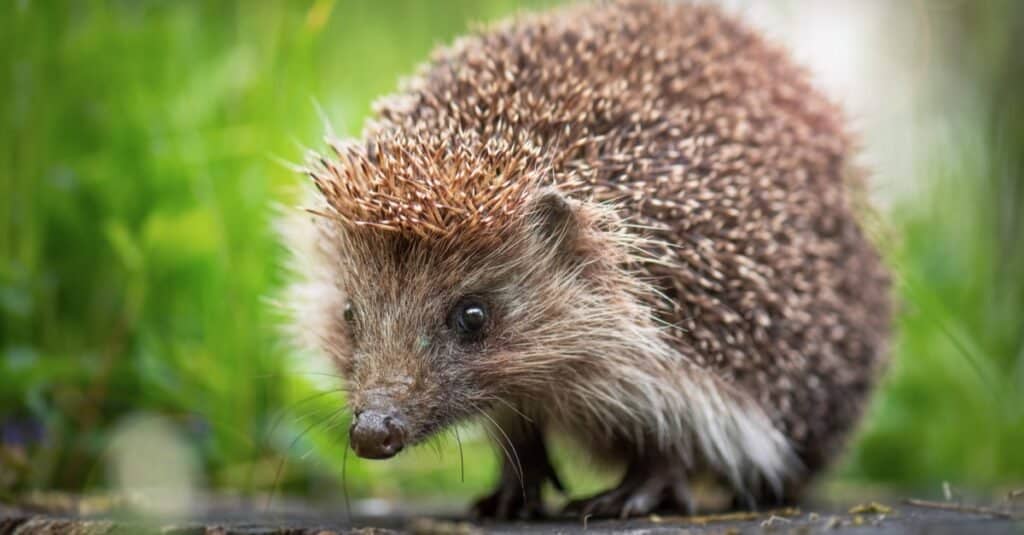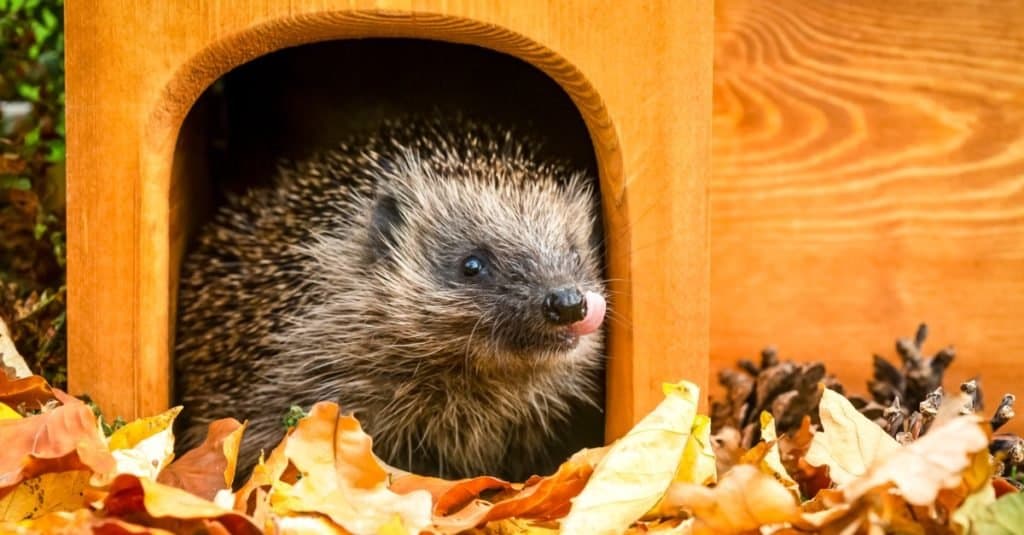They’re adorable, roly-poly, and spiky — and wildly popular among folks thinking of something other than the usual cat, dog, or hamster. The hedgehog, a tiny mammal with prickly spines on its back, has become a wildly popular choice for pet enthusiasts in the past decade or so. Scroll through Instagram and YouTube and you’ll find tons of videos of these cute little balls of fluff and quills doing all sorts of things. From bathing in the sink to curling up tightly into a ball, or nibbling on tasty produce, these little guys are just fun to watch!

But if you want to bring one home, thinking through the costs could be the critical point for making it possible. They’re technically exotic pets, so standard fees and supplies (and regulations and laws) don’t apply.
Let’s look through the costs, the needs, and all the basics to see if bringing home a little hedgie is the right choice for you.
How Much Does a Hedgehog Cost?

The adorable little hedgehog rolls into a ball to protect itself when it feels threatened.
©iStock.com/serikbaib
Several factors play into the initial and long-term costs of purchasing and caring for a pet hedgehog.
First off, the hedgehog itself can run anywhere from $100 to $300 these days, depending on the one you choose to bring home.
The coloration of the hedgie is one of the most significant factors in cost. The second factor is where you get them: pet store versus breeder. Occasionally, you may find one at a local animal shelter or rescue, as well, which would cost you less but prove harder to find.
Ideally, spend some time researching prices at local, viable options where hedgehogs are sold.
Remember though, the cost doesn’t stop here. You’ve got equipment, food, and health care to consider.
Hedgehog Cost by Coloration – Lowest to Highest
| Color | Low | High |
|---|---|---|
| Salt & Pepper | $100 | $200 |
| Cinnamon | $100 | $200 |
| Algerian | $175 | $250 |
| Pinto | $175 | $250 |
| Champagne | $200 | $225 |
| Apricot | $200 | $225 |
| Snowflake | $200 | $275 |
| White | $250 | $275 |
| Albino | $250 | $300 |
| Black | $250 | $300 |
How Much Does a Hedgehog Cage Cost?

The quills on the back of the hedgehog are made from keratin.
©DenisNata/Shutterstock.com
Before you bring your new hedgie home, you’ll need to find an appropriate cage. If your budget is tighter, you can look on sites like Craigslist and Freecycle and keep an eye for a while until one becomes available for free or next to free. However, if you’re planning to bring home that hedgie soon, you’ll find brand new offerings at retailers will usually run between $60 and $175.
The cage should be between 2.5 and 4 square feet to ensure your pal has enough space for moving around. They need a solid bottom cage, too, not a wire bottom.
Be sure to purchase a smaller, extra cage as well, to use for transport. Your hedgie will have some trips ahead of him throughout his lifetime, mostly heading into the vet for his annual checkups and care.
How Much Does Hedgehog Food Cost?

When held carefully, the hedgehog quills don’t hurt your hands.
©Elijus3000/Shutterstock.com
It’s important that your hedgie gets the proper nutrition. In other words, you can just feed her cat food or something. That means you’ll need proper food formulated for hedgehogs. Sites like Chewy have the food available for about $35 for a 5-pound bag.
Hedgies usually eat between 70 and 100 calories per day, which means between 1 and 3 tablespoons of food each day. However, the little critters will overeat if you feed them too much, so make sure you only give them the right amount each day. This means the 5-pound bag of food will last a pretty good long while.
Add in fresh fruits and veggies to round out their nutrition, as well, which will add a little more cost each month. Ideally, to save cash, cut up the fruit and veggies in advance and freeze the leftovers so nothing goes to waste. Then, thaw the produce and feed it to your pal once it’s the right temperature.
Additionally, hedgehogs are natural insectivores, meaning they eat bugs. They’ll do best if they’re kept with a partial diet of live or dried insects. Boiled eggs, pinky mice, and other small amounts of cooked (but unseasoned) meat will improve their diet and overall health as well.
Overall, you’ll probably spend around $15 to $20 total per month on their food, including the bagged hedgie food, produce, insects, and meat.
What’s the Cost for Insurance and Health Care for Hedgies?
Reports tell us that annual vet visits for a checkup usually run between $45 and $75, depending on your location. If you’re near exotic pet vets who know hedgies, this should be pretty accurate. If you live someplace more obscure, it may be harder to find a vet nearby, meaning costs will go up because of further transit.
Hedgies usually live about 5 years, when properly care for, so you can anticipate these annual visits 5 times, plus any special visits for some of their other needs that may arise.
Hedgies most commonly deal with:
- Dental problems
- Uterine cancer
- Eye problems
- Obesity
- Neurological issues
- Ectoparasites (similar to mites)
- Respiratory infections
- Urinary tract issues
Insurance for your hedgie is a good idea because of these potential issues. They need annual visits as well as fecal exams and bloodwork (usually about $100). Occasionally, dental cleanings come up, as well, running around $100 each time. They’ll also need flea, tick, and worm treatments occasionally, which run about $15 to $25 each.
Within about 2 weeks of bringing your new hedgie home, it’s a good idea to bring your pal to the vet to be spayed or neutered. This initial cost usually runs between $250 and $400, since they’re considered an exotic pet. This procedure will improve the health and living of your hedgie.
Basic Supply List for Hedgies

A relatively common pet, the baby hedgehog, also called a hoglet, is both cute and playful.
©iStock.com/Carmelka
- Cage
- Hideaway hut
- Food bowls
- Water bottle
- Toys
- Treats
- Food
- Cage accessories
- Nail trimmer
- Cleaning supplies
- Vitamins and supplements
- Supplementary produce
- Travel carrier
- Bedding or cage liners
- Heating
- Exercise wheel
Cost for Toys
On average, you’ll find you spend about $10 a month on toys for your hedgie. They love playing and the toys help keep them active and healthy, making the toys important for their health.
Cost for Bedding
Most likely, your hedgie’s bedding will run you about $10 a month. If she’s particularly messy or a lot of spills happen, it may be more like $15 to $17.
Cost for Exercise Wheel
Hedgehogs have a tendency toward obesity, so it’s important to watch the food you give them and provide an exercise wheel. The wheel will help keep them active in their cage at night.
Exercise wheels for hedgies range anywhere from $10 to $50, depending on how fancy you want to get.
Cost for Heating

Hedgehogs naturally love living in gardens, but they hibernate if it gets too cold!
©HildaWeges/Shutterstock.com
Hedgehogs need to have a warm, clean, comfortable cage. A heating pad and thermometer to keep the temperature regulated are necessary. As long as they’re taken care of properly, you shouldn’t need to replace either of these more than once, at the most, in your hedgie’s lifetime. Together, the two will probably run you between $60 and $100.
Total Costs of Bringing Home a Hedgehog
Initial costs will include all of the following, including the hedgie you bring home.
- $100 — $300 for your hedgehog
- $50 — food, bowls, and water bowls
- $60 — $175 for cage
- $60 — carrier cage
- $20 — $30 for toys
- $10 to $50 — exercise wheel
- $10 — $15 for bedding
- $250 — $400 for spay/neuter
- $45 — $75 for initial check-up
- $60 — $100 for heating pad and thermometer
- $50 — hideaway and other cage setup supplies
Overall, your total home cost will run you between $715 to $1325 to bring home your hedgehog, all things included.
Monthly Costs for a Hedgehog
Total each month, you should expect your hedgehog care to cost:
- $15 — $20 for food and treats
- $10 — bedding
- $10 — toys
- $5 — $10 for additional supplies or incidentals
- $15 — insurance
Total, you’re looking at $55 to $65 per month.
Total Annual Cost Of Owning A Hedgehog
The annual cost for your hedgehog will probably run you between $705 to $855.
It’s important to remember that all of these figures are just estimates. Things like your chosen hedgie coloration and distance you are to an exotic pet vet impact your overall and regular costs.
Helpful and Fun Facts About Hedgies

Hedgehogs need a hideaway in their cage. They’re solitary and nocturnal.
©Coatesy/Shutterstock.com
One important fact everyone should know about hedgies: Some states have strict laws against keeping hedgehogs as pets, so it’s important to know what your state laws say before bringing one home. Some states that restrict hedgehog ownership include Vermont, Hawaii, Alabama, California, Georgia, Maine, Pennsylvania, Oregon, Washington D.C., parts of Nebraska, and all of New York City.
Hedgie Behavior Facts
- Though it’s usually quiet and may be hard to hear, hedgehogs are known to purr. They sound a little bit like baby pigs as they purr, which is partially how they get their name of ‘hedgehog’ (emphasis on the “hog”). They make this little grunting noise as they look for food in the wild.
- The other part of their name (hedge) comes from their unique foraging habits of seeking their prey in hedgerows and shrubs, using their long snouts to find them.
- Hedgies aren’t group animals – they much prefer to live and move alone. So, that’s good news for your bills – you don’t need to bring two home for happy hedgies. In fact, they only get together with other hedgies for mating season.
- When a hedgehog feels threatened, she’ll curl up in a ball, tucking her belly inside and her quills outside. This helps them protect their vulnerable parts.
- Hedgehogs are actually known to hunt down and eat venomous snakes in the wild. They’re not particularly susceptible to many of the venomous snakes, which is part of why they have been popular in the past as garden animals. This is not why they were sent to New Zealand though – there are no snakes there.
- In cold climates, hedgehogs hibernate in winter. For hedgies in hot climates like deserts, aestivation during droughts or extreme heat is what they do instead. Basically, this is hot-weather hibernation, functionally speaking, in which the animals live dormant with lowered metabolisms until its safe to come out again.
- Hedgies are also popular garden animals in some places of Europe because of their great love of insects. They forage for the insects that destroy gardens, saving gardeners a lot of annoyance.
- In captivity, hedgies have a lifespan of 5 to 7 years, while in the wild they only live 2 to 4 years.
- Hedgies are known to be “self-anointers.” They’ll chew on toxic substances and mix these with their saliva and rub this on their bodies. Nobody really knows why they do this, but some think it’s to make themselves inedible to predators.
Physical Features of Hedgehogs
- Even though hedgies look a hint like porcupines, they are vastly different animals. Their quills, for example, look similar, but porcupine quills release when they feel threatened. Hedgehogs don’t “shoot” their quills. They’re not quills at all, but spines that don’t have barbs or venom but are hollow.
- Hedgehogs have tiny tails that we can’t really see because of all the quills! But turn them over and the tiny little nubby tail becomes visible.
- Hedgehogs have a lot of those spines (quills). The average adult hedgehog has between 5,000 and 7,000 quills alone. Each year, the quills shed and regrow completely new.
- Hedgehogs aren’t usually smelly animals unless you don’t bathe them and keep their cages clean. They don’t have the scent glands like ferrets do. If they do start to smell bad, it could be an indicator that the hedgehog isn’t feeling well and needs to see the vet.
- Baby hedgies have sharper quills than adults. They will shed these and grow in softer ones. This is known as quilling.
- Even though they look sharp (and can be!), hedgehogs can easily be handled, if you’re careful. Gently hold the hedgehog to avoid the pain. They like being stroked on their quills as well, so gentle petting is much desired.
- Hedgehogs don’t have a great sense of sight. In fact, they have amazing hearing and senses of smell instead and use these to guide themselves in the world.
Other Fun Facts About Hedgies
- A group of hedgehogs is called an array or a prickle. A baby hedgie is known as a hoglet.
- The most common species of hedgehog found as pets in the USA are African pygmy hedgehogs. They’re a hybrid of the four-toed hedgehog and the North African hedgehog.
- In some places, you’ll find the Long-eared hedgehog or the Indian long-eared hedgehog as well, and may be able to purchase them as pets.
- It’s important for human health to keep your hedgies clean. They are prone to carrying diseases that can affect humans, even if you’ve had them for a while. It’s an ongoing risk.
- There are records of hedgehogs kept as pets dating all the way back to 4 B.C.
- Hedgehogs are not native to New Zealand (only 2 bat species and marine mammals are native mammals!), but they were brought over by early European settlers. They live in the wild now and in many cases are considered pests.
- Seventeen species of hedgehogs exist in the world.
The photo featured at the top of this post is © KAMONRAT/Shutterstock.com
Thank you for reading! Have some feedback for us? Contact the AZ Animals editorial team.







